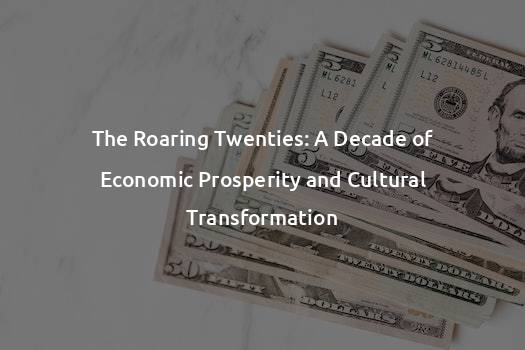The Roaring Twenties: A Decade of Economic Prosperity and Cultural Transformation
The Roaring Twenties, often referred to as the Jazz Age, was a transformative period in American history marked by economic prosperity and cultural revolution. This decade saw unprecedented economic growth, new technologies, and a significant shift in social and cultural norms. From advancements in industries to the rise of consumer culture and the revolution of entertainment, the 1920s were a time of great change and excitement.
Economic Prosperity
The 1920s witnessed remarkable economic growth and prosperity in the United States. Following the end of World War I, the country experienced a sustained period of economic expansion. Industries such as automobiles, construction, and consumer goods thrived, providing employment opportunities and boosting national GDP.
One of the key drivers of the economic boom was the rise of mass production and assembly line techniques pioneered by Henry Ford in the automotive industry. The Ford Model T, an affordable automobile, became immensely popular, revolutionizing transportation and contributing to the significant increase in car ownership.
Moreover, the 1920s marked a shift towards a more consumer-driven society. Americans were spending more on consumer goods such as radios, refrigerators, and washing machines, fueled by easy credit and installment plans. The availability of electricity in many homes also contributed to the increase in demand for these modern conveniences.
Cultural Transformation
Beyond the economic prosperity, the Roaring Twenties witnessed a cultural revolution that challenged traditional values and introduced a new way of life.
Flappers and Changing Roles of Women
One of the iconic symbols of the 1920s was the flapper. Representing a generation of young women, flappers discarded the traditional restrictive Victorian fashion and embraced shorter skirts, bobbed hairstyles, and a more liberated lifestyle. They challenged societal norms by smoking in public, drinking alcohol, and participating in activities once deemed inappropriate for women.
Women’s roles in society also saw significant changes during this period. The 19th Amendment, which granted women the right to vote in 1920, gave them a voice in the political arena. Women began to join the workforce in large numbers and pursued careers outside of traditional roles as teachers or nurses.
Prohibition and Speakeasies
One of the most famous aspects of the 1920s was the Prohibition era. The 18th Amendment, enacted in 1920, prohibited the manufacturing, sale, and transportation of alcoholic beverages. However, this ban led to the rise of illegal establishments called speakeasies, where people would go to indulge in drinking and revelry. Prohibition, while ultimately deemed a failure, had a significant impact on American society and culture.
Jazz and the Harlem Renaissance
The Roaring Twenties were also known as the Jazz Age due to the rise of this distinctly American genre of music. Jazz, characterized by its syncopated rhythms and improvisational nature, gained immense popularity. African American musicians, notably Louis Armstrong and Duke Ellington, played a crucial role in popularizing jazz and contributing to the cultural renaissance known as the Harlem Renaissance.
This cultural movement in Harlem, New York, celebrated African American art, literature, and music, challenging the prevalent racial stereotypes of the time. The Harlem Renaissance brought black culture and talent into the mainstream, paving the way for future generations of artists and writers.
Art deco, an influential artistic style of the era, emerged during the Roaring Twenties. Known for its bold geometric shapes and glamorous aesthetic, art deco influenced architecture, fashion, and design, leaving an indelible mark on the culture of the time.
Conclusion
The Roaring Twenties was an extraordinary era that brought remarkable economic prosperity and cultural transformation to the United States. The decade witnessed rapid changes in industry and the rise of consumer culture, leading to unprecedented economic growth. Socially, the 1920s challenged traditional norms, giving rise to empowered women and a vibrant cultural revolution.
This period’s legacy can still be felt today—the innovative developments, radical changes, and cultural movements shaped American society and left an indelible mark on the country’s history, making it one of the most iconic decades of the 20th century.
TL;DR
The Roaring Twenties were marked by economic prosperity and cultural transformation in the United States. The decade saw significant economic growth, fueled by mass production, consumerism, and advancements in industries, notably the automobile industry. Culturally, the 1920s challenged traditional values and introduced a more liberated lifestyle, symbolized by flappers and changing roles for women. Prohibition gave rise to speakeasies and jazz music, paving the way for the Harlem Renaissance—a cultural movement celebrating African American art. The legacy of the Roaring Twenties can still be seen today, with its impact on American society and its status as an iconic era of the 20th century.







